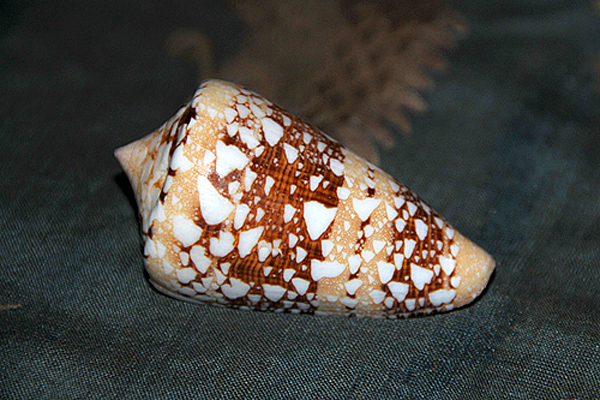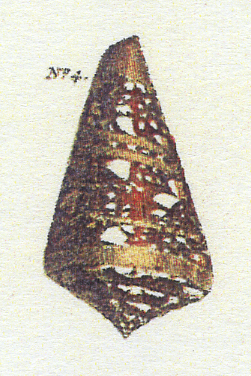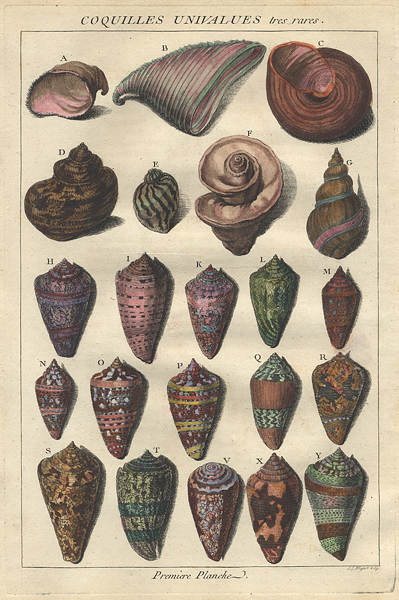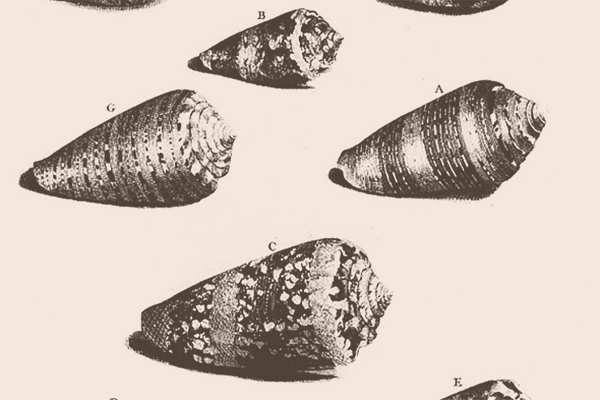
Until Dunn made the distinction, C. cedonulli had been confused with C. ammiralis, especially after Linnaeus added C. ammiralis cedonulli as an additional form. (The cone was so named because the golden stripes were reminiscent of those on an admiral's sleeve. Like tulips, it may have been that the name was given to make the shell more desirable, just as a beautiful flamed tulip had been called Admirael der Admiraels de Gouda.)

This C. ammiralis is from the same plate in Seba's Thesaurus as the Cedo nulli (Volume III, Pl. XLVIII, fig. 8).

And these two examples of C. ammiralis are among the tres rares shells of d'Argenville's Conchyliologie (1757). Linnaeus, too, singles out the species and its varieties as rare in Systema Naturae (10th ed., 1758, p. 713).

Unlike the black and white example above, this page from d'Argenville's Conchyliologie has been colored by hand, although with mixed results. Of the figures illustrating C. ammiralis (N, O, P), only the latter approximates the actual shell. C. cedonulli is represented by Figure H, although from the fanciful coloring one would be hard put to recognize it. The Nautile Vitré (Carinaria cristata) takes pride of place at the top as Figure B, the translucent shell given more color by art than nature. (Its name, "Glassy Nautilus" actually is a misnomer, D'Argenville having mistaken it for the shell of a cephalopod.) Indeed, because the color scheme of any shell is important to its identification, this imaginative enhancement of the original print (especially when the colorist likely has not even seen the specimen) makes that task only more difficult.

"Thus far we followed the Author [Rumphius]; but since the most estimable Whelks are among the aforementioned Toots [Voluta] (as was said before), we could not neglect to show to the Collectors, the rarest ones, which the Author could not have known, and which are seldom found, all of them shown on Plate XXXIV....The one shown by the letter B, is called the Supreme Admiral, since it was, before the other became known, the foremost Whelk....its color is a yellowish brown, with flamed stripes that are browner, and that are intertwined, with white spots like hearts; [it] has four yellow bands around it, with fine white little spots, and it is toothed or topped all around its crown."
Rumphius, The Ambonese Curiosity Cabinet (II. Appendix)
Plate XXXIV depicts several examples of C. ammiralis, which, given species variation, cannot be identified with any more certitude. But the description of the cone identified by the letter B at least begins to approximate the C. ammiralis ammiralis in the photograph.
A bibliographic note: In 1758, in the tenth edition of the Systema Naturae, Carl Linnaeus sought to enumerate and describe every plant and animal known to him, each to be uniquely identified by two latinized words (its binomen), the first indicating the genus to which the organism belonged, the second, the species. But as revolutionary as this system of binomial nomenclature was in classifying species, it had not been practical for Linnaeus to illustrate his work. Instead, shell collectors in the eighteenth-century had to depend on others, such as Seba or Regenfuss, whose work also appeared that year, or d'Argenville and Knorr, who had published the year before.
In 1757, just as Michel Adanson was proposing a classification of mollusks based on their anatomical characteristics (anticipating Linnaeus by a year) and illustrated books were making shells easier to identify and collect, the craze for collecting was beginning to pass. The collection auctioned that year by the French ambassador to The Hague would, in retrospect, be regarded as a high point and very few sales during the second half of the eighteenth century would be as successful. Collected shells were becoming monotonously similar, with fewer new varieties being found. All this would change with the voyages of James Cook to the unexplored South Seas between 1768-1780. No longer would the Netherlands be the center of shell collecting, as those from Dutch colonies gave way to new varieties from the Pacific.
There was one other event in 1757: Having surrendered the day before to the French general at Fort William Henry in northeastern New York State, British troops were ambushed by France's Native American allies. It was this incident that inspired James Fenimore Cooper to write The Last of the Mohicans. The broader international conflict (that had begun the year before) would continue as the Seven Years' War.
References: "On the Identity of Conus cedonulli Linnaeus 1767" (1971) by V. Rodger Dunn, The Veliger, 13(3), 290-291; Shell Collecting: An Illustrated History (1966) by S. Peter Dance; Linnaeus: Systema naturae (1758), 10th ed. (p. 713, no.257); L'histoire naturelle, éclaircie dans une de ses parties principales, la conchyliologie, que traite des coquillages de mer, de riviere et de terre (1757) by A. J. Dézallier d'Argenville (pp. 381-394); Albertus Seba: Cabinet of Natural Curiosities (2001) by Irmgard Müsch, Jes Rust, and Rainer Willmann.